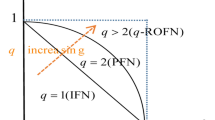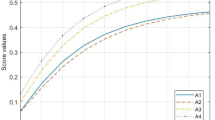Abstract
In this paper, we propose a hybrid concept of q-rung orthopair fuzzy soft set and hypersoft set (HSS), called q-rung orthopair fuzzy hypersoft set (q-ROFHSS), which is used to express insufficient and undefined information in decision-making problems. Then we define some basic operations for q-ROFHS number (q-ROFHSN). Furthermore, correlation coefficients (CC) have been applied widely in many research domains and practical fields. In this work, we present correlation coefficients, weighted correlation coefficients, and some properties are also discussed, and then correlation coefficient-based TOPSIS (prioritization technique for order preference by similarity to ideal solution) method is developed under the q-rung orthopair fuzzy hypersoft settings. Using the established TOPSIS method, a decision-making procedure is proposed under q-rung orthopair fuzzy hypersoft environment to solve the uncertain and ambiguous information. In the end, a practical example is investigated and a comparison analysis is executed with other existing methods to illustrate the feasibility, practicality and superiority of our proposed method.

Similar content being viewed by others
References
Zadeh, L.A.: Information and control. Fuzzy Sets 8, 338–353 (1965)
Pawlak, Z., Grzymala-Busse, J., Slowinski, R., Ziarko, W.: Rough sets. Commun. ACM. 38, 88–95 (1995)
Molodtsov, D.: Soft set theory—first results. Comput. Math. Appl. 37, 19–31 (1999)
Atanassov, K.T.: Two theorems for intuitionistic fuzzy sets. Fuzzy Sets Syst. 110, 267–269 (2000)
De, S.K., Biswas, R., Roy, A.R.: An application of intuitionistic fuzzy sets in medical diagnosis. Fuzzy Sets Syst. 117, 209–213 (2001)
Szmidt, E., Kacprzyk, J.: Distances between intuitionistic fuzzy sets. Fuzzy Sets Syst. 114, 505–518 (2000)
Du, W.S.: Subtraction and division operations on intuitionistic fuzzy sets derived from the Hamming distance. Inf. Sci. (Ny) 571, 206–224 (2021)
Yager, R.R.: Pythagorean fuzzy subsets. In: 2013 Joint IFSA World Congress and NAFIPS Annual Meeting (IFSA/NAFIPS), pp. 57–61. IEEE (2013)
Yager, R.R.: Pythagorean membership grades in multicriteria decision making. IEEE Trans. Fuzzy Syst. 22, 958–965 (2013)
Peng, X., Yang, Y.: Some results for Pythagorean fuzzy sets. Int. J. Intell. Syst. 30, 1133–1160 (2015)
Zhang, X., Xu, Z.: Extension of TOPSIS to multiple criteria decision making with Pythagorean fuzzy sets. Int. J. Intell. Syst. 29, 1061–1078 (2014)
Wei, G., Lu, M.: Pythagorean fuzzy power aggregation operators in multiple attribute decision making. Int. J. Intell. Syst. 33, 169–186 (2018)
Garg, H.: A new generalized Pythagorean fuzzy information aggregation using Einstein operations and its application to decision making. Int. J. Intell. Syst. 31, 886–920 (2016)
Garg, H.: Hesitant Pythagorean fuzzy sets and their aggregation operators in multiple attribute decision-making. Int. J. Uncertain. Quantif. 8 (2018)
Garg, H.: A novel accuracy function under interval-valued Pythagorean fuzzy environment for solving multicriteria decision making problem. J. Intell. Fuzzy Syst. 31, 529–540 (2016)
Peng, X., Yang, Y.: Fundamental properties of interval-valued Pythagorean fuzzy aggregation operators. Int. J. Intell. Syst. 31, 444–487 (2016)
Wu, Q., Lin, W., Zhou, L., Chen, Y., Chen, H.: Enhancing multiple attribute group decision making flexibility based on information fusion technique and hesitant Pythagorean fuzzy sets. Comput. Ind. Eng. 127, 954–970 (2019)
Yager, R.R.: Generalized orthopair fuzzy sets. IEEE Trans. Fuzzy Syst. 25, 1222–1230 (2016)
Wei, G., Gao, H., Wei, Y.: Some q-rung orthopair fuzzy Heronian mean operators in multiple attribute decision making. Int. J. Intell. Syst. 33, 1426–1458 (2018)
Ali, M.I.: Another view on q-rung orthopair fuzzy sets. Int. J. Intell. Syst. 33, 2139–2153 (2018)
Yager, R.R., Alajlan, N.: Approximate reasoning with generalized orthopair fuzzy sets. Inf. Fusion. 38, 65–73 (2017)
Liu, P., Wang, P.: Multiple-attribute decision-making based on Archimedean Bonferroni Operators of q-rung orthopair fuzzy numbers. IEEE Trans. Fuzzy Syst. 27, 834–848 (2018)
Peng, X., Dai, J., Garg, H.: Exponential operation and aggregation operator for q-rung orthopair fuzzy set and their decision-making method with a new score function. Int. J. Intell. Syst. 33, 2255–2282 (2018)
Liu, Z., Liu, P., Liang, X.: Multiple attribute decision-making method for dealing with heterogeneous relationship among attributes and unknown attribute weight information under q-rung orthopair fuzzy environment. Int. J. Intell. Syst. 33, 1900–1928 (2018)
Joshi, B.P., Singh, A., Bhatt, P.K., Vaisla, K.S.: Interval valued q-rung orthopair fuzzy sets and their properties. J. Intell. Fuzzy Syst. 35, 5225–5230 (2018)
Wang, J., Gao, H., Wei, G., Wei, Y.: Methods for multiple-attribute group decision making with q-rung interval-valued orthopair fuzzy information and their applications to the selection of green suppliers. Symmetry (Basel) 11, 56 (2019)
Du, W.S.: Minkowski-type distance measures for generalized orthopair fuzzy sets. Int. J. Intell. Syst. 33, 802–817 (2018)
Tang, G., Yang, Y., Gu, X., Chiclana, F., Liu, P., Wang, F.: A new integrated multi-attribute decision-making approach for mobile medical app evaluation under q-rung orthopair fuzzy environment. Expert Syst. Appl. 200, 117034 (2022)
Tang, G., Chiclana, F., Liu, P.: A decision-theoretic rough set model with q-rung orthopair fuzzy information and its application in stock investment evaluation. Appl. Soft Comput. 91, 106212 (2020)
Tang, G., Long, J., Gu, X., Chiclana, F., Liu, P., Wang, F.: Interval type-2 fuzzy programming method for risky multicriteria decision-making with heterogeneous relationship. Inf. Sci. (Ny) 584, 184–211 (2022)
Tang, G., Chiclana, F., Lin, X., Liu, P.: Interval type-2 fuzzy multi-attribute decision-making approaches for evaluating the service quality of Chinese commercial banks. Knowl.-Based Syst. 193, 105438 (2020)
Maji, P.K., Biswas, R., Roy, A.R.: Soft set theory. Comput. Math. Appl. 45, 555–562 (2003)
Ali, M.I., Feng, F., Liu, X., Min, W.K., Shabir, M.: On some new operations in soft set theory. Comput. Math. Appl. 57, 1547–1553 (2009)
Maji, P.K., Biswas, R.K., Roy, A.: Fuzzy soft sets. (2001)
Maji, P.K., Biswas, R., Roy, A.R.: Intuitionistic fuzzy soft sets. J. Fuzzy Math. 9, 677–692 (2001)
Arora, R., Garg, H.: A robust aggregation operators for multi-criteria decision-making with intuitionistic fuzzy soft set environment. Sci. Iran. 25, 931–942 (2018)
Geng, S., Li, Y., Feng, F., Wang, X.: Generalized intuitionistic fuzzy soft sets and multiattribute decision making. In: 2011 4th International Conference on Biomedical Engineering and Informatics (BMEI), pp. 2206–2211. IEEE (2011)
Feng, F., Fujita, H., Ali, M.I., Yager, R.R., Liu, X.: Another view on generalized intuitionistic fuzzy soft sets and related multiattribute decision making methods. IEEE Trans. Fuzzy Syst. 27, 474–488 (2018)
Jiang, Y., Tang, Y., Chen, Q.: An adjustable approach to intuitionistic fuzzy soft sets based decision making. Appl. Math. Model. 35, 824–836 (2011)
Peng, X.D., Yang, Y., Song, J., Jiang, Y.: Pythagorean fuzzy soft set and its application. Comput. Eng. 41, 224–229 (2015)
Athira, T.M., John, S.J., Garg, H.: A novel entropy measure of Pythagorean fuzzy soft sets. AIMS Math. 5, 1050–1061 (2020)
Zulqarnain, R.M., Xin, X.L., Garg, H., Khan, W.A.: Aggregation operators of Pythagorean fuzzy soft sets with their application for green supplier chain management. J. Intell. Fuzzy Syst. 40, 5545–5563 (2021). https://doi.org/10.3233/JIFS-202781
Chinram, R., Hussain, A., Ali, M.I., Mahmood, T.: Some geometric aggregation operators under q-rung orthopair fuzzy soft information with their applications in multi-criteria decision making. IEEE Access. 9, 31975–31993 (2021)
Smarandache, F.: Extension of soft set to hypersoft set, and then to plithogenic hypersoft set. Neutrosophic Sets Syst. 22, 168–170 (2018)
Zulqarnain, R.M., Xin, X.L., Saeed, M.: Extension of TOPSIS method under intuitionistic fuzzy hypersoft environment based on correlation coefficient and aggregation operators to solve decision making problem. AIMS Math. 6, 2732–2755 (2020)
Zulqarnain, R.M., Xin, X.L., Saeed, M.: A development of Pythagorean fuzzy hypersoft set with basic operations and decision-making approach based on the correlation coefficient. Theory Appl. Hypersoft Set. 6 (2021)
Zulqarnain, R.M., Siddique, I., Jarad, F., Ali, R., Abdeljawad, T.: Development of TOPSIS technique under Pythagorean Fuzzy hypersoft environment based on correlation coefficient and its application towards the selection of antivirus mask in COVID-19 pandemic. Complexity 2021, 6634991 (2021). https://doi.org/10.1155/2021/6634991
Liu, Z., Wang, D., Wang, X., Zhao, X., Liu, P.: A generalized TODIM-ELECTRE II based integrated decision-making framework for technology selection of energy conservation and emission reduction with unknown weight information. Eng. Appl. Artif. Intell. 101, 104224 (2021)
Liu, Z., Wang, D., Wang, W., Liu, P.: An integrated group decision-making framework for selecting cloud service providers based on regret theory and EVAMIX with hybrid information. Int. J. Intell. Syst. 37, 3480–3513 (2022)
Hwang, C.-L., Yoon, K.: Methods for multiple attribute decision making. In: Multiple Attribute Decision Making, pp. 58–191. Springer, New York (1981)
Xu, Z., Zhang, X.: Hesitant fuzzy multi-attribute decision making based on TOPSIS with incomplete weight information. Knowl.-Based Syst. 52, 53–64 (2013)
Zeng, S., Xiao, Y.: TOPSIS method for intuitionistic fuzzy multiple-criteria decision making and its application to investment selection. Kybernetes 45, 282–296 (2016). https://doi.org/10.1108/K-04-2015-0093
Joshi, D., Kumar, S.: Intuitionistic fuzzy entropy and distance measure based TOPSIS method for multi-criteria decision making. Egypt. Inf. J. 15, 97–104 (2014)
Garg, H.: A new improved score function of an interval-valued Pythagorean fuzzy set based TOPSIS method. Int. J. Uncertain. Quantif. 7 (2017)
Liu, P., Liu, P., Wang, P., Zhu, B.: An extended multiple attribute group decision making method based on q-Rung orthopair fuzzy numbers. IEEE Access. 7, 162050–162061 (2019)
Zulqarnain, R.M., Abdal, S., Maalik, A., Ali, B., Zafar, Z., Ahamad, M.I., Younas, S., Mariam, A., Dayan, F.: Application of TOPSIS method in decision making via soft set. Biomed J Sci Tech Res. 24 (2020)
Garg, H., Arora, R.: TOPSIS method based on correlation coefficient for solving decision-making problems with intuitionistic fuzzy soft set information. AIMS Math. 5, 2944–2966 (2020)
Acknowledgements
The work was supported by National Natural Science Foundation of China (Grant Nos. 71871001, 71771001, 72001001); Natural Science Foundation for Distinguished Young Scholars of Anhui Province (Grant No. 1908085J03); Research Funding Project of Academic and technical leaders and reserve candidates in Anhui Province (Grant No.2018H179).
Funding
This work was provided by the National Natural Science Foundation of China (Grant Nos. 71871001, 71771001, 72001001); Natural Science Foundation for Distinguished Young Scholars of Anhui Province (Grant No. 1908085J03); Research Funding Project of Academic and technical leaders and reserve candidates in Anhui Province (Grant No.2018H179).
Author information
Authors and Affiliations
Contributions
SHG: conceptualization, formal analysis, writing—original draft, writing—review and editing, methodology. HC: supervision, investigation, validation, writing—review and editing. YB: calculation, software.
Corresponding author
Ethics declarations
Conflict of interest
The authors declare that they have no known competing financial interests or personal relationships that could have appeared to influence the work reported in this paper.
Informed Consent
All authors agreed to this submission.
Rights and permissions
Springer Nature or its licensor holds exclusive rights to this article under a publishing agreement with the author(s) or other rightsholder(s); author self-archiving of the accepted manuscript version of this article is solely governed by the terms of such publishing agreement and applicable law.
About this article
Cite this article
Gurmani, S.H., Chen, H. & Bai, Y. Extension of TOPSIS Method Under q-Rung Orthopair Fuzzy Hypersoft Environment Based on Correlation Coefficients and Its Applications to Multi-Attribute Group Decision-Making. Int. J. Fuzzy Syst. 25, 1–14 (2023). https://doi.org/10.1007/s40815-022-01386-w
Received:
Revised:
Accepted:
Published:
Issue Date:
DOI: https://doi.org/10.1007/s40815-022-01386-w




